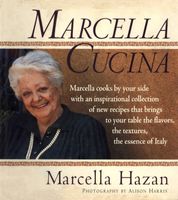Advertisement
The Unique Cooking Method
Appears in
Published 1997
- When you have sautéed the base ingredients, turn up the heat to high, add the raw, unwashed rice, and scald it, stirring thoroughly to coat every grain.
- Add a ladleful of cooking liquid to the pot, stirring the contents, scraping them away from the bottom and sides with your wooden spoon or spatula, until the liquid is gone. Whenever you find that there is no more liquid in the pot, add less than a cup at a time, stirring constantly, wiping the sides and bottom of the pot clean as you stir. You must never stop stirring and you must be sure to frequently wipe the bottom of pot completely clean, or the rice will stick to it.
- Taste the rice after it has been cooking for 20 minutes. It is done when it is tender, but firm to the bite. As it gets close to that stage, gradually reduce the amount of liquid you add, so that when the risotto is fully cooked, it is just slightly moist, but not runny.
- The final step is called mantecare. The word is borrowed from the Spanish for butter, mantequilla. In Italian it means to work butter or cream into what you are cooking to give it a soft consistency. In making risotto you do it when the risotto is cooked but is still steaming in the pot. You add a tablespoon or two of butter and a half cupful or so of grated Parmesan, and swirl them in vigorously. It is the final and best touch, bestowing on your risotto a creamy consistency of great opulence. It is generally applied to risottos made over a base that contains butter. Sometimes you may feel justified in breaking the rule and you will mantecare with butter even if there was oil in the base. In most cases, however, if a risotto has been made with olive oil, before you remove it from the pot, stir into it a tablespoon or two of fine raw extra virgin olive oil.

